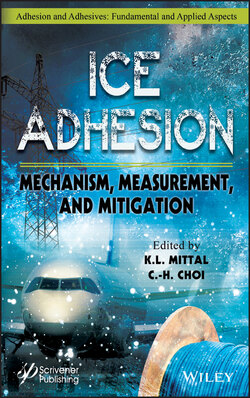Читать книгу Ice Adhesion - Группа авторов - Страница 18
1.2.3 Predicting Delays in Ice Nucleation
ОглавлениеOften the experimental parameter of interest in anti-icing surface engineering is the rate at which critically-sized embryos of the new thermodynamic phase will form, and the icing delay time offered by a surface. Pruppacher and Klett (1980) extended the CNT to estimate the nucleation rate, J(T), via Equation 1.15 [81]
(1.15)
Figure 1.6 Rendering of the hypothetically best surface morphology to delay the nucleation of ice according to the heterogeneous classical nucleation theory. This surface is decorated with nano-scale concavities, with no nanoconvexities.
where K and kB denote the kinetic prefactor accounting for diffusive flux of water molecules across the ice embryo/water interface and the Boltzmann constant, respectively. The kinetic prefactor, K, can be related to the diffusion activation energy required for a water molecule to cross the water-ice interface, ∆Fdiff, as given by Equation 1.16 [81].
(1.16)
where h and n are the Planck constant and the number density of water molecules at the ice embryo/water interface (n ≈ 1019 m–2), respectively. The diffusion activation energy can be calculated using the empirical Vogel-Fulcher-Tammann diffusivity relationship to yield Equation 1.17 [82, 83].
(1.17)
where E and TR are empirical fitting parameters with values for liquid water of E = 892 K and Tr = 118 K in the temperature range of 150-273 K [83].
The stochastic process of water nucleating into ice follows the binomial distribution; that is, each ice embryo has the binary outcome of either reaching the critical radius to become stable, or not. Each growing ice embryo is one of n independent experiments within the binomial distribution. Further, each of these experiments has a low probability, p. Distributions such as these can be approximated well by a Poisson distribution. If the mean number of events that occur in one unit time, λ, is a constant then the phenomenon studied is deemed a homogeneous Poisson point process. The homogeneous Poisson distribution is given by Equation 1.18 [84].
(1.18)
Thus, the probability density function of the lifetime of a liquid droplet in contact with a surface can be found by setting x = 1 (i.e. ice embryos are not reaching the critical radius) and λ = J(T).
(1.19)
where the subscript c denotes that the process is occurring at constant temperature. The expected time delay in freezing water, τ, at a given constant temperature can thus be calculated using Equation 1.20.
(1.20)
